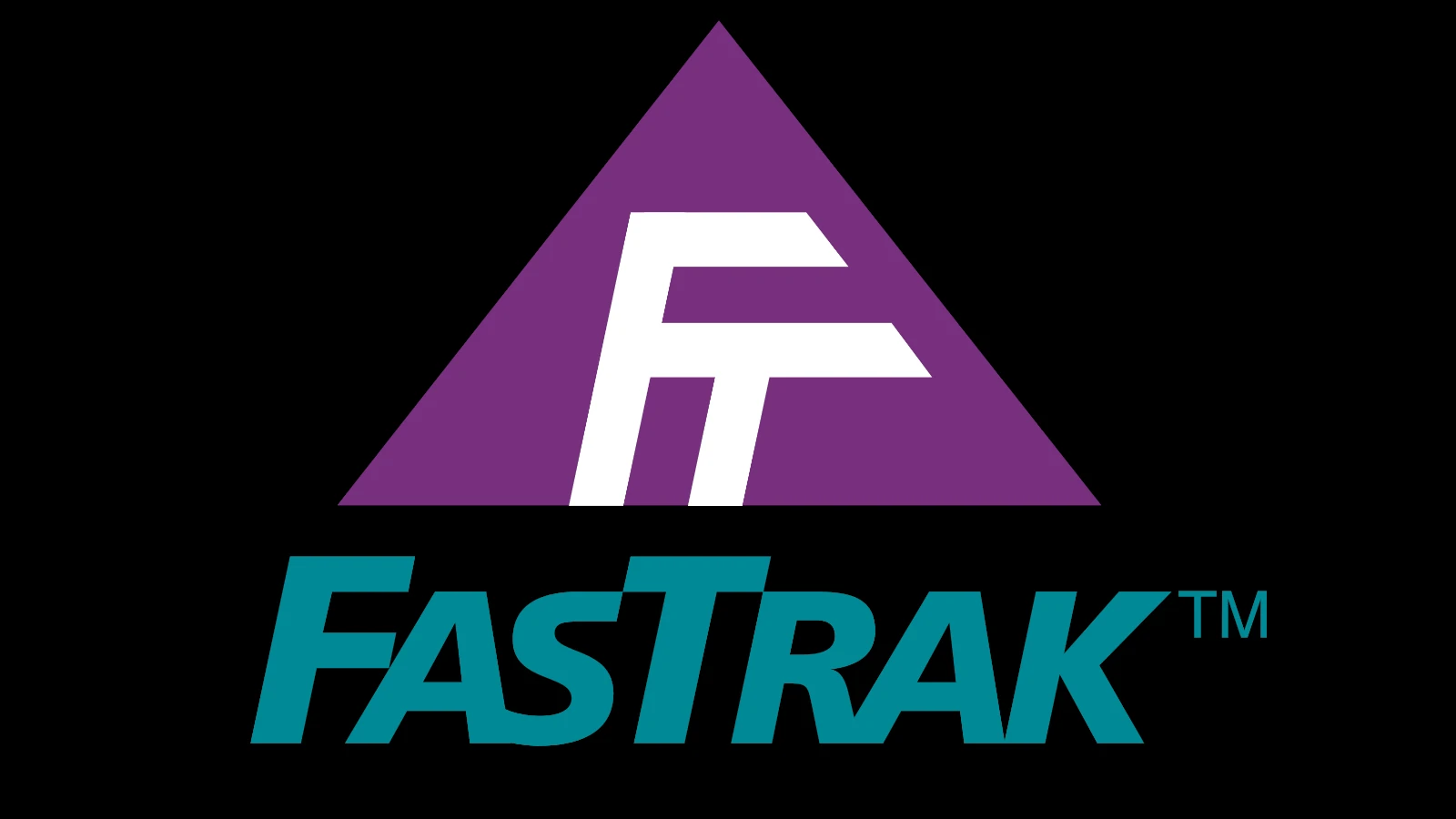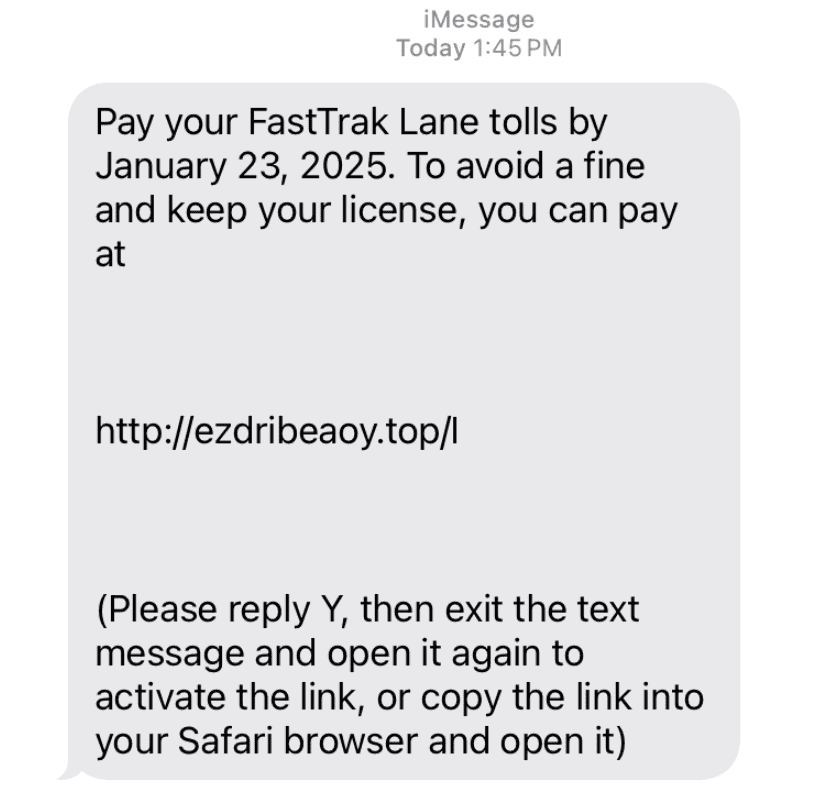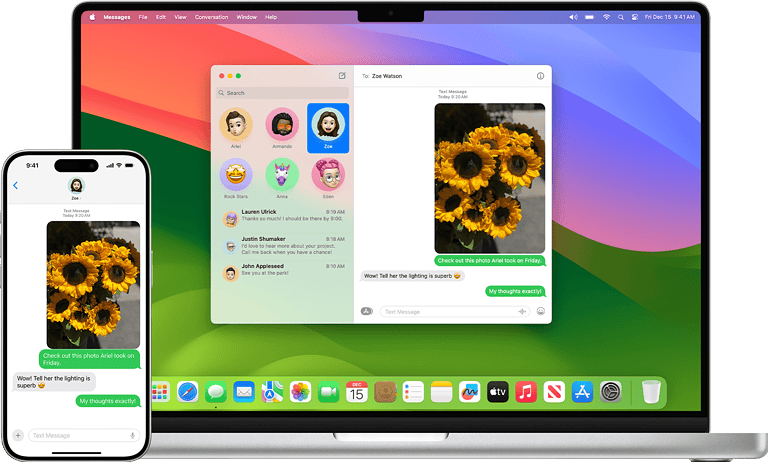
A new text message scam targeting FasTrak users has emerged, claiming unpaid tolls and threatening excessive late fees. These deceptive messages are not from FasTrak and aim to trick recipients into providing personal information or money. Scammers impersonate legitimate toll collection agencies, sending texts with urgent payment demands and fake links to fraudulent websites.
FasTrak, California’s electronic toll collection system, does not use text messages for billing issues. The scam exploits people’s fear of fines and legal action to pressure them into quick payments. Victims who click on the provided links risk exposing their personal and financial data to criminals.

Here is the text of the scam:
Pay your FastTrak Lane tolls by January 23, 2025. To avoid a fine and keep your license, you can pay at
[URL REDACTED]
(Please reply Y, then exit the text message and open it again to activate the link, or copy the link into your Safari browser and open it)
Protect Yourself from Toll Text Scams
How the FasTrak Text Scam Works
The FasTrak text scam tricks people into giving up their money and personal information. Scammers send text messages that look like they’re from FasTrak or another toll collection agency. These texts often say you owe money for unpaid tolls and threaten late fees if you don’t pay right away. The texts include a link to a website. This website looks real, but it’s fake. If you enter your payment information on this fake site, the scammers steal it.
Why This Scam Is Effective
This scam works because it uses a few common tricks:
- Urgency: The texts create a sense of panic. They make you think you must pay immediately to avoid extra charges.
- Authority: The texts pretend to be from a trusted source, like FasTrak. This makes them seem real.
- Simple Action: The texts ask you to do one simple thing: click a link and pay. This makes it easy to fall for the scam.
Spotting a Fake FasTrak Text
Here are some ways to tell if a FasTrak text is fake:
- Unexpected Message: FasTrak usually sends bills by mail or email. They rarely send texts about unpaid tolls.
- Suspicious Link: Don’t click on links in texts from unknown numbers. Go directly to the official FasTrak website if you need to check your account.
- Generic Greeting: Scam texts often use general greetings like “Dear Customer” instead of your name.
- Grammar and Spelling Errors: Scam texts often have typos and bad grammar.
What to Do If You Get a Scam Text
If you get a suspicious text about FasTrak tolls:
- Don’t click the link.
- Report the text to FasTrak. You can find contact information on their website.
- Report the scam to the Federal Trade Commission (FTC). You can report it online at ReportFraud.ftc.gov.
- Delete the text.
Comparing Real and Fake FasTrak Communication
| Feature | Real FasTrak Communication | Scam Text |
|---|---|---|
| Method | Mail, email | Text message |
| Personalization | Uses your name or account number | Generic greeting |
| Links | Links to official FasTrak website | Links to fake website |
| Urgency | May include due dates, but without aggressive threats | Creates a strong sense of panic |
Protecting Yourself from Future Scams
Here are some tips to stay safe from scams:
- Be careful about giving out personal information online or over the phone.
- Use strong passwords for your online accounts.
- Keep your software up to date.
- Be skeptical of unexpected messages.
Other Types of Toll Scams
Besides text scams, there are other ways scammers try to trick drivers:
- Fake Websites: Scammers create fake websites that look like official toll payment sites.
- Phone Calls: Scammers call people pretending to be from toll agencies and ask for payment information.
To avoid these scams, always go directly to the official website of your tolling agency to pay bills or check your account. Never give out personal information over the phone unless you initiated the call to a known, trusted number.
The rise of digital toll collection has brought convenience, but it has also opened new avenues for scams. Understanding how these scams operate can help you stay safe. By being aware of the tactics scammers use and taking simple precautions, you can protect yourself from becoming a victim.
The Electronic Toll Collection (ETC) industry is constantly changing. New technologies, like automatic license plate readers and smartphone apps for toll payment, are making toll collection easier. But these changes can also create new opportunities for scams. Keep up with the latest news and information from your local tolling agency to stay informed about potential risks and ways to protect yourself.
For example, some states are moving towards all-electronic tolling, where there are no toll booths at all. This means drivers must have an electronic transponder or pay online. Scammers might take advantage of this by creating fake websites or apps that claim to offer toll payment services. Always use the official channels provided by your state or local tolling authority to avoid these scams.
Staying informed about these changes and practicing safe online habits are the best ways to protect yourself from toll scams.
Key Takeaways
- Text messages demanding FasTrak toll payments are fraudulent and should be ignored
- FasTrak does not use text messages for billing or collection purposes
- Report suspicious toll-related texts to authorities and verify concerns through official channels
Understanding the FastTrak Lane Toll Scam
The rise of electronic toll collection (ETC) systems like FasTrak has increased commuting efficiency but also created opportunities for scams. In 2023, the FTC reported over 2.4 million fraud incidents, with imposter scams being prevalent. A specific scam targets ETC users, sending fake messages about unpaid tolls and urging immediate payment through phishing links. Recognizing these scams is vital to protect against financial loss and identity theft.
The FastTrak Lane toll scam exploits unsuspecting drivers through deceptive text messages. Scammers impersonate legitimate toll collection services to steal money and personal information.
Mechanisms of the Toll Scam
The scam starts with a fraudulent text message claiming to be from FasTrak. This message states that the recipient owes money for toll charges. It often includes a specific amount due and a deadline for payment.
The text warns of consequences for non-payment, such as excessive late fees or potential legal action. A link is provided, directing victims to a fake payment portal.
This portal is designed to capture sensitive information like credit card details or driver’s license numbers. Scammers use this data for identity theft or financial fraud.
The Dangers of Phishing Scams
Phishing attempts like the FasTrak scam pose serious risks to victims. Clicking on links in suspicious messages can lead to malware installation on devices.
Entering personal information on fake websites exposes individuals to identity theft. Financial losses can occur if scammers gain access to bank accounts or credit cards.
These scams can damage credit scores and create long-term financial problems. Victims may also face emotional stress and time-consuming efforts to recover stolen identities.
Identifying the Red Flags
Several warning signs can help spot the FasTrak Lane toll scam. Legitimate toll agencies do not typically send text messages about billing issues.
Unsolicited messages demanding immediate payment should raise suspicion. Threats of legal action or license suspension are often tactics used by scammers.
Carefully examine the sender’s information and any links provided. Legitimate URLs usually match the official website of the organization.
Be wary of messages containing spelling errors or poor grammar. Official communications are generally well-written and professional.
Never provide personal or financial information in response to unexpected messages. Contact the toll agency directly using official channels to verify any claims.
Preventive Measures against Toll Scams
Toll scams pose a significant threat to drivers’ personal and financial security. Awareness and proactive steps can help protect individuals from falling victim to these deceptive schemes.
Protecting Personal and Financial Information
Drivers should never click on links in unsolicited text messages about tolls. FasTrak and other legitimate toll agencies do not send text messages about billing issues. It’s crucial to verify the source of any communication regarding tolls.
- Use official websites for toll payments
- Keep toll transponder account information private
- Regularly monitor bank and credit card statements
- Enable two-factor authentication on financial accounts
Drivers can contact their toll agency directly through official channels if they have concerns about their account or payments.
Responding to Suspected Scam Attempts
If a driver receives a suspicious text about toll payments, they should:
- Do not respond or click any links
- Report the message to their local law enforcement
- Forward the text to 7726 (SPAM) to alert mobile carriers
- File a complaint with the Federal Trade Commission
It’s important to alert friends and family about these scams. Drivers who believe they’ve fallen victim to a toll scam should immediately contact their bank or credit card company to dispute any charges and protect their accounts from further unauthorized access.
Legitimate FastTrak Procedures and Payments
FastTrak offers electronic toll collection for highways and bridges in California. The system uses transponders to charge tolls automatically, simplifying payments for drivers.
Understanding Electronic Toll Collection
FastTrak transponders link to prepaid accounts. Drivers mount the device on their windshield. Sensors detect the transponder at toll points and deduct the fee automatically.
Accounts require a minimum balance. Users can set up auto-replenishment or add funds manually. FastTrak works on all Bay Area bridges and express lanes.
To open an account, drivers visit bayareafastrak.org. The website lets users manage their account, view transactions, and update payment methods.
FastTrak offers different transponder types:
- Standard tag (for most vehicles)
- FasTrak Flex (for carpools and clean air vehicles)
- Sticker tag (for motorcycles)
Handling Unpaid Tolls and Notices
If a driver uses a toll facility without a FastTrak account, they receive a violation notice. The notice includes:
- Date and time of the violation
- Location
- Vehicle information
- Amount due
- Payment instructions
Drivers have 21 days to pay or contest the notice. Payment options include:
- Online at bayareafastrak.org
- By mail
- By phone
Ignoring violations leads to penalties. Late fees increase the amount owed. Multiple unpaid tolls may result in:
- DMV registration holds
- Collections actions
- Additional fines
To resolve unpaid tolls, drivers should contact FastTrak customer service promptly. Representatives can explain payment options and help set up accounts to avoid future violations.
Frequently Asked Questions
FasTrak toll scam text messages can be deceptive and pose financial risks. Understanding how to identify and respond to these fraudulent messages is crucial for protecting personal information and avoiding financial losses.
How can one identify a FasTrak toll scam via text message?
Scam texts often contain urgent language and pressure recipients to act quickly. They may include suspicious links or request personal information. Legitimate FasTrak messages never ask for immediate payment or sensitive data via text.
What steps should be taken if a suspicious text message is received regarding unpaid tolls?
Recipients should not click any links or respond to the message. Contacting FasTrak directly through official channels is the best course of action. Reporting the suspicious text to local authorities or consumer protection agencies can help prevent others from falling victim.
How does FasTrak officially communicate toll fees to customers?
FasTrak typically sends official communications through mail or email. They do not use text messages for billing or fee collection. Customers can check their account status through the official FasTrak website or by calling customer service.
What are the common characteristics of fraudulent toll road text messages?
Fraudulent messages often contain spelling errors or poor grammar. They may use generic greetings and threaten penalties for non-payment. Scam texts frequently include shortened URLs or request payment through unconventional methods.
Are there safeguards in place to protect against e-toll scam texts?
Mobile carriers offer spam filtering services. Users can enable these features to reduce the number of scam texts received. Some smartphones have built-in safety features that warn users about potentially malicious links.
Who should be contacted to report a potential toll scam received through text?
Reports can be filed with the Federal Trade Commission (FTC) or local law enforcement. Notifying the official FasTrak customer service helps them track and combat scam attempts. State consumer protection offices also accept and investigate fraud reports.





